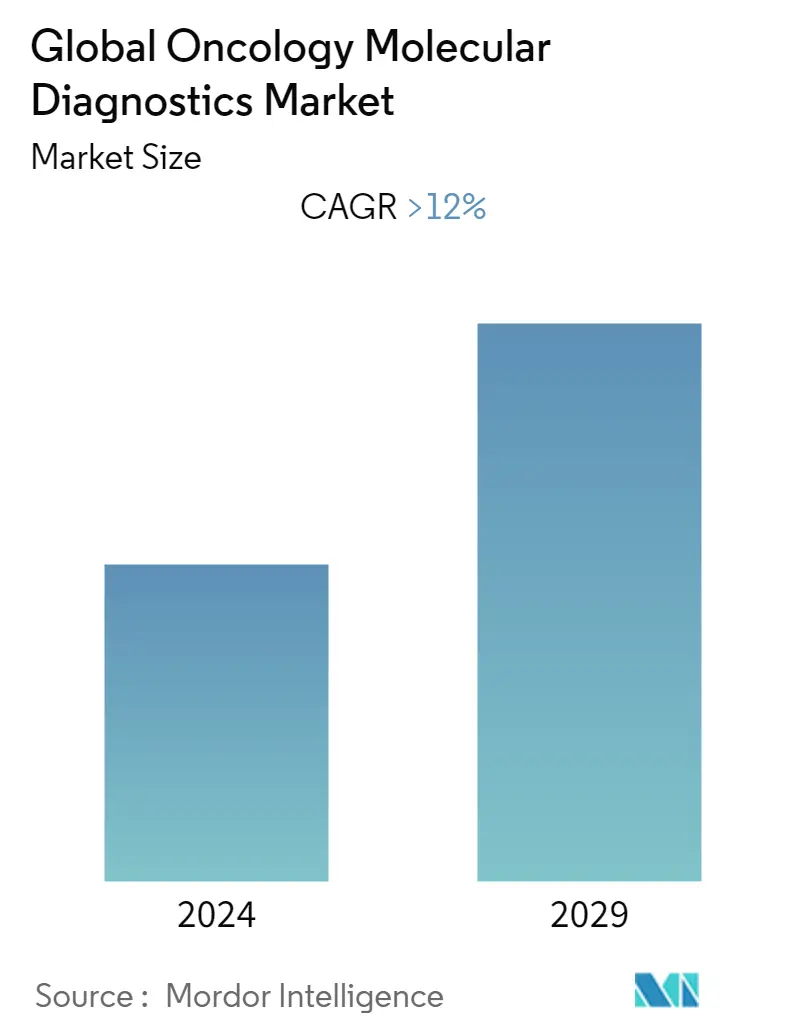Market Size of Global Oncology Molecular Diagnostics Industry

| Study Period | 2019 - 2029 |
| Base Year For Estimation | 2023 |
| CAGR | > 12.00 % |
| Fastest Growing Market | Asia-Pacific |
| Largest Market | North America |
| Market Concentration | High |
Major Players
*Disclaimer: Major Players sorted in no particular order |
Need a report that reflects how COVID-19 has impacted this market and its growth?
Oncology Molecular Diagnostics Market Analysis
The oncology molecular diagnostics market is expected to register a CAGR of more than 12 % during the forecast period.
The COVID-19 pandemic has significantly impacted the oncology molecular diagnostics market. As per the Association for Molecular Pathology (AMP), 2021 survey of 163 laboratories, worldwide, 85% of the respondents reported that molecular testing for cancer decreased during April-June 2020. Additionally, more than half of respondents revealed that oncology testing for clinical trials decreased due to lower enrollment, reluctance to travel, and the ability to perform testing. The survey results also indicate that the pandemic may continue to have long-term effects on molecular diagnostic testing for cancer. Additionally, laboratories and universities engaged in the R&D of cancer have witnessed a halt in activities across the world. Moreover, the government funding from various organizations for the research is on hold in several regions of the world.
The growth of the market studied can be largely attributed to the factors, such as the rising prevalence of cancer, worldwide, technological advancements in diagnostic testing, and increasing demand for point-of-care testing. These factors are leading to increasing demand for oncology molecular diagnostics.
The rising prevalence of cancer cases across the world is contributing to the increasing demand for diagnosis, which is boosting the oncology molecular diagnostics market. According to the World Health Organization (WHO), cancer accounted for approximately 10 million deaths in 2020. Additionally, as per the 2021 statistics by the American Cancer Society, by 2040, the global burden of cancer is expected to grow to 27.5 million new cases and 16.3 million cancer deaths. Such high numbers indicate that the estimated rising prevalence of cancer is contributing to the increasing need for early diagnosis and preventive medicine. Thus, in view of the factors mentioned above, the demand for oncology molecular diagnostic tests is consistently increasing.
Additionally, due to the increasing technological advancements in diagnostic testing, there is a growing usage of molecular diagnostics tests for oncology. Several advancements are being made in cancer genome sequencing, computational analysis, tumor models, and innovative cancer research methods. For instance, Roche Molecular Systems, Inc. developed Cobas EGFR Mutation Test for non-small cell lung cancer patients and received approval from the United States Food and Drug Administration (USFDA) in 2020 and is a real-time PCR test to detect 42 mutations of the epidermal growth factor receptor (EGFR) gene. Moreover, in March 2021, Cancer Research UK and Capital Enterprises and Roche UK together launched the Cancer Tech Accelerator program. The new initiative may aid researchers in translating their ideas and lifesaving innovations. Thus, in view of the factors mentioned above, the market is anticipated to witness significant growth over the forecast period.
However, the high cost of molecular diagnostic tests, lack of skilled workforce, and stringent regulatory framework are some of the factors impeding the market growth.
